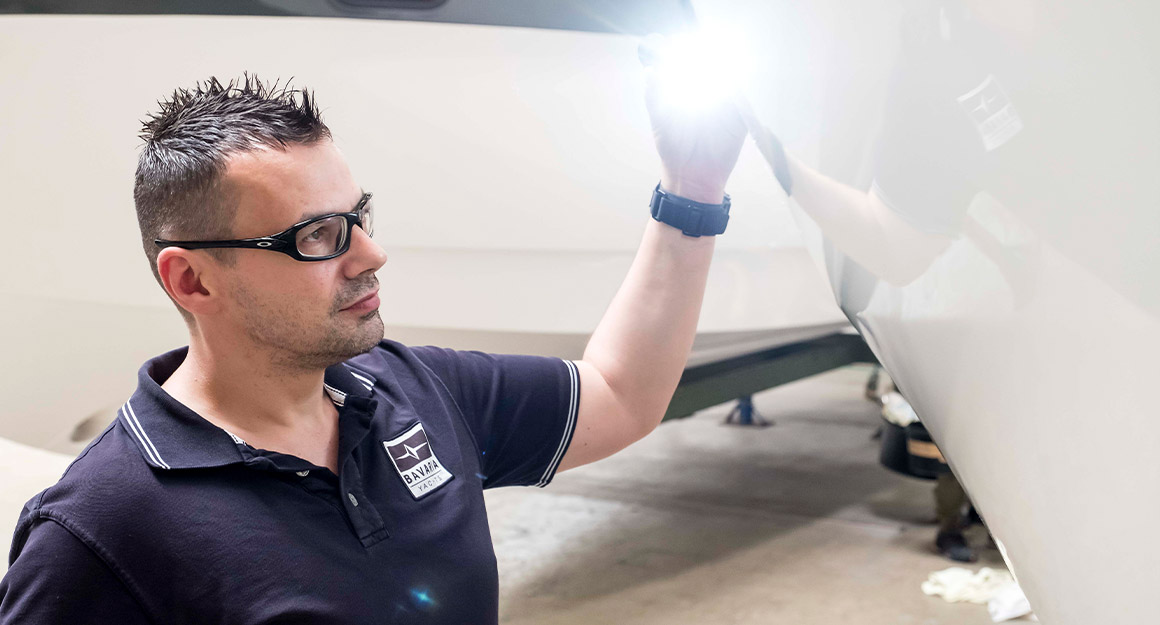Boat building on the assembly line
Since its foundation, BAVARIA YACHTS has been known for its efficient production of yachts. Since September last year, BAVARIA has taken this philosophy of intelligent and effective organization to a new level: With a process that is also known in the industry as „value stream organization“, as Karsten Danker, division manager for the sailing yachts, explains.

Since 2000, BAVARIA YACHTS has been manufacturing on four production lines.
The boats come out of the lamination as more or less empty hulls, Danker explains. In the case of the sailing yachts, the engines and, above all, the „backbone“, a large, stable floor assembly that stiffens the boat and is the basis for further construction, which now takes place on the assembly lines, are already pre‐assembled. Likewise, the hulls and decks have already come through the gigantic CNC milling machine where all the hull openings have been cut: Board passages, windows and hatches.
Now each boat goes through further stations: Station One, wiring. Or station two, installation of the furniture modules, which are already delivered to the assembly line from the carpentry workshop, station three, lamination of the modules, and so on. Everything is thoroughly planned, like Swiss clockwork. Because planning is the key to success. Since all boats are only built to order and no two are exactly the same, the construction slots have to be allocated very carefully, depending on the order, the type of boat and the equipment. No easy task for Christina Issing, who is responsible for the processes within the company organization.

Until the wedding, when the deck is placed on the hull…

... all fittings and installations are done.
A well‐rehearsed team works at every station on the line. Worksheets that record the standard procedure ensure clarity and make it easier for new employees to get started. There are a total of four belts at BAVARIA YACHTS, with belt number four reserved for the „exotics“. These are the large motor yachts that don’t quite fit into series production, explains Andre Kirchner, head of the motorboat division.
The other belts each have about 30 stations, where each boat spends about a day before moving on to the next step. Sailing yachts from 45 to 57 feet are built on line 1, where each boat stays for 1.2 days per station and four boats leave the line every week. On belt 2 are the sailing yachts from 34 to 42 feet in length with 0.8 days per station, with six boats per week, and on belt 3 the motorboats of up to 40 feet in length spend 0.7 days per station with five boats per week. So on average it takes around six weeks for a boat to be finished on the line. In addition to that, there are also the lamination process beforehand and the final finishing before delivery that need to be considered as well. The "marriage", i.e. the joining of hull and deck, takes place shortly before station 13 and the keel assembly for the sailing yachts in the last third. Both are important milestones in the genesis of any boat.

The cabins come as finished modules...

... and are placed directly into the hull.
The advantages of this modern mode of production are convincing. Short distances, quick decisions within the team and a lean organization ensure the best efficiency with a high degree of cost‐effectiveness, which is above all to the customer’s advantage.
Thorough planning is required in advance, especially when introducing new boat types. Usually, the first one or two yachts are built as prototypes, if possible already within set times of the teams on the production line. This way, it is quickly determined whether assembly line production is possible, and whether the timing is right. In this phase, specialized industrial technicians make sure that the new developments are ready for production. Once this has been achieved, series production starts from hull three at the latest.
It’s a fascinating process in which everything interlocks smoothly. Or to put it another way: like a regatta crew in a race. Everyone has their own task when sailing and everyone knows what to do – then all manoeuvres succeed and a perfect result is guaranteed.




